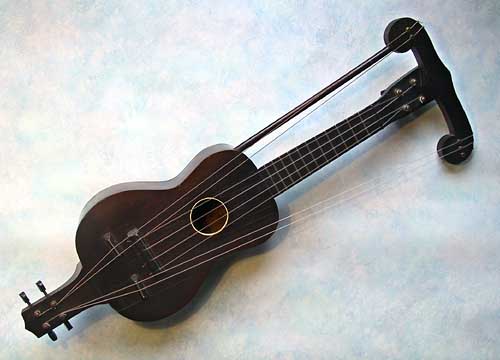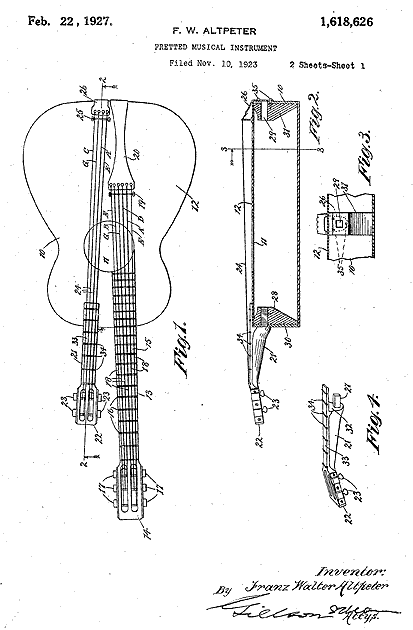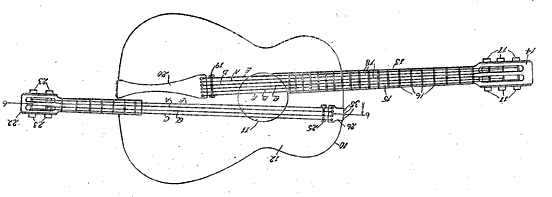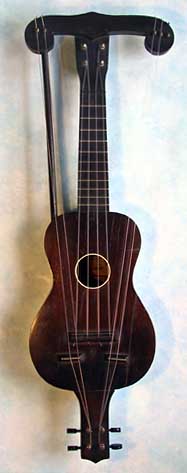Altpeter Harp
Guitar and Double-Harp
Ukulele
by Gregg Miner
|
A slightly modified version of
this article is included in
Harp
Ukuleles |
|
|
Update! August,
2008 |
|
| This
bizarre little beast is a "Double Bass Uke" made by Franz
Walter Altpeter of Chicago in 1927. You gotta love this guy!
Almost nothing is known of Altpeter, and so far, this seems to be the
only instrument of his that anyone has ever seen! DOUBLE BASS UKES I'm assuming the patent date reflects the patent for a somewhat different instrument which Altpeter was granted on Feb. 22, 1927 (thanks to Michael Holmes of Mugwumps Online for leading me to it). This equally strange instrument is shown below. |
 |
 |
Alpeter
talks about this invention for two-plus pages, but what it boils down to
is a harp guitar-like concept to be applied to any type of fretted
instrument (including ukulele?).
The first feature of the patent is to cover a "new method" of playing, which is to string it backwards and strum the three high accompaniment strings with the thumb (preferably with a metal thumbpick to "add materially to the loudness"), plucking the lower strings with the fingers. Altpeter then continues on about the volume problem of guitars and similar instruments, suggesting the addition of open bass strings ("four are usually sufficient for most players"). He doesn't acknowledge that many makers had created versions of harp guitars for the same reason prior to this (in fact, Altpeter's were probably the very last to be introduced). Of course, his bass strings are on the opposite side of the neck, to be played with the fingers, because of the backwards tuning! (He does provide for "normal" playing, and the drawing shows the guitar's main strings in normal tuning - in which case the extra bass strings are really in a strange location) Best of all, because "it is sometimes desirable that the auxiliary neck extend from the body in a direction opposite from the main neck," he proposes a removable neck which can be fitted to either end of the body! For those of us who have difficulty looking over the bulky arm of our Dyer and Knutsen harp guitars, this sounds like a great idea! Who knows what they would've sounded like however, not to mention the wacky appearance (see alternate version below!) I suspect that few (if any?) of these instruments were made or sold (anyone with any info, please write in!). |

 |
Which
brings us to the one instrument we do have available: the Double Bass
Uke.
The neck contains the standard four ukulele strings (we can only guess if they were to be tuned backwards!). What I call the "yoke" has nails to loop one end of the auxiliary strings around and slotted screws to act as a nut/guides. Perhaps inspired by the patent idea, the geared tuners for these strings are not at the top where they'd normally be, but protruding from the other end! Things become more curious when we begin counting the appendages: Four auxiliary tuners; two auxiliary bridges flanking the normal bridge - each with three slots; and finally, two nails/nuts on the left side of the yoke and three on the other. Additionally, the yoke is asymmetrical with a support on the left side only. All of this appears original. My guess is that the overly creative Altpeter is again giving us options: a maximum of four auxiliary strings, with the option of either two on each side, one on the left - three on the right, or perhaps only one side to be used by the performer. The question is: WHY? Again, a guess. Perhaps his patent idea gave rise to the "Double Bass" concept. That is, auxiliary strings on both sides of the standard neck, so that the player can use (and string and tune) whichever side best suits their playing style. I can see him having difficulty with the patent instrument, and evolving into a "left-or-right" harp guitar. The label implies that he also built some of these "Double Bass Guitars" also (he uses the term "bass" where others would use "harp" - most likely because the extra strings were to be bass strings, and/or the European use of "bass guitar" in place of "harp guitar"). Thus, I would imagine that the uke was also tuned with the extra strings as "bass" strings (but what an idea!). They sure get in the way of strumming, but I'm experimenting with some fingerstyle techniques. This incredibly rare instrument is in part a Museum donation from the Chuck Fayne collection. Now has anyone seen a guitar? |
|
If you enjoyed this article, or found it useful for research, please consider making a donation to The Harp Guitar Foundation, which supports Harpguitars.net so that this information will be available for others like you and to future generations. Thank you for your support! |
|
If you enjoyed this article, or found it
useful for research, please consider making a donation to The
Harp Guitar Foundation, |
|
|
|
All Site Contents Copyright © Gregg Miner,2004-2020. All Rights Reserved. Copyright and Fair Use of material and use of images: See Copyright and Fair Use policy. |